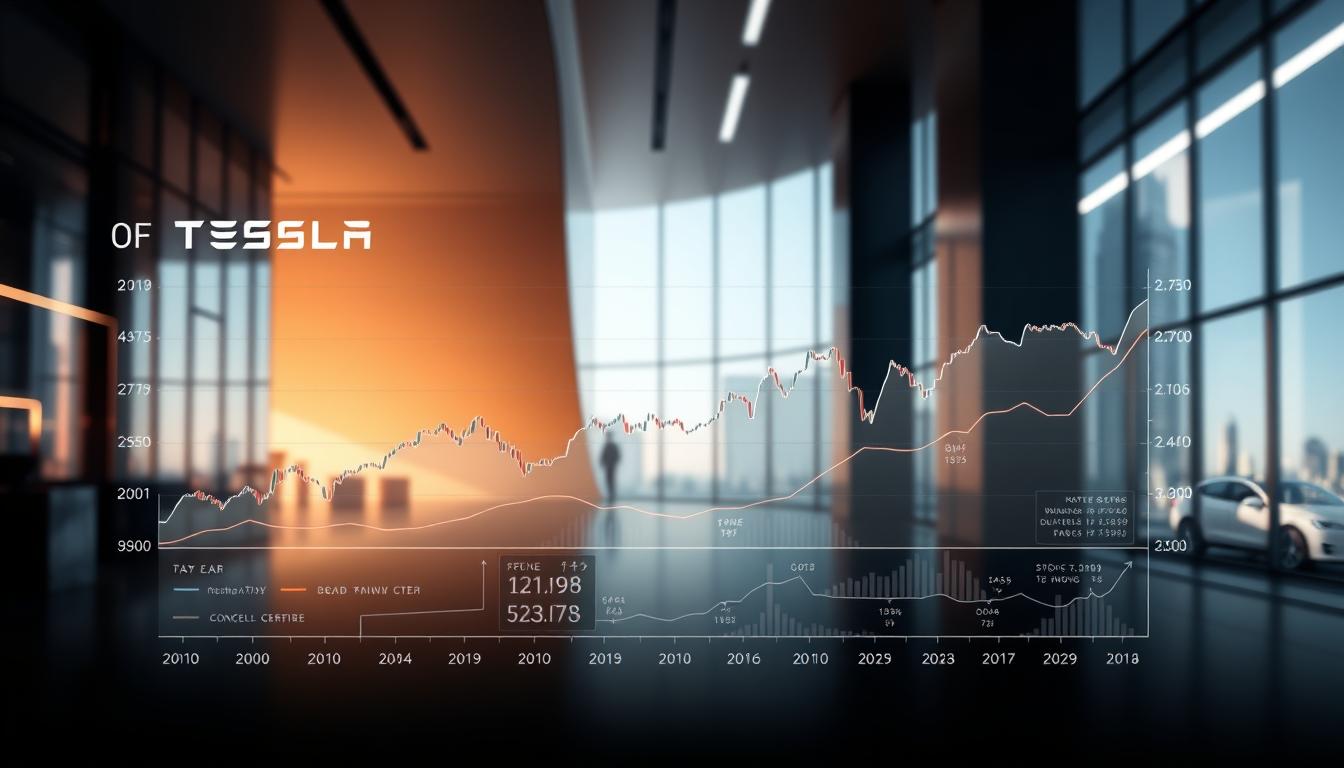The world of finance is constantly evolving, and tesla stock is at the forefront of this change. As a leader in the electric vehicle industry, Tesla’s market performance is closely watched by investors and analysts alike.

Analyzing the latest trends and insights is crucial for understanding the dynamics of Tesla’s stock. This involves examining market trends, financial reports, and industry developments to predict future performance.
Our analysis will delve into the current state of tesla stock, exploring factors that influence its value and providing insights into what the future may hold.
Key Takeaways
- Understanding the current trends in Tesla’s stock performance.
- Analyzing the factors that influence Tesla’s stock value.
- Gaining insights into the future performance of Tesla’s stock.
- Exploring the impact of industry developments on Tesla’s stock.
- Reviewing financial reports to predict future stock performance.
Current Tesla Stock Performance and Market Dynamics
As the electric vehicle market continues to evolve, Tesla’s stock has shown significant fluctuations, driven by various market dynamics. Investors are closely monitoring these changes to gauge the company’s future prospects.
Recent Price Movements and Trading Patterns
Tesla’s stock has experienced notable price movements in recent weeks, influenced by both internal factors and broader market trends. Trading patterns indicate a mix of investor sentiment and reactions to market news.
The stock’s volatility is reflected in its trading volume, with significant spikes observed during periods of heightened market activity.
Year-to-Date Performance Compared to Market Indices
Tesla’s year-to-date performance is a key indicator of its relative strength within the market. The following table compares Tesla’s YTD performance with major market indices.
| Index | Year-to-Date Performance |
|---|---|
| Tesla | +20% |
| S&P 500 | +10% |
| Nasdaq Composite | +15% |
This comparison highlights Tesla’s competitive position, with its YTD performance outpacing major indices.
Tesla’s Competitive Position in the EV Market
The electric vehicle market is becoming increasingly crowded, with Tesla facing stiff competition from both traditional automakers and new entrants. Despite this, Tesla maintains a strong presence in the global EV market.
Global Market Share and Regional Performance
Tesla’s global market share in the EV sector remains significant, although it has decreased slightly due to increased competition. The company’s regional performance varies, with strong sales in North America and Europe. In Asia, Tesla faces intense competition from local manufacturers.
Comparison with Traditional Automakers and EV Startups
Tesla is often compared to both traditional automakers and EV startups. While traditional automakers like General Motors and Volkswagen are rapidly expanding their EV offerings, EV startups like Rivian and Lucid Motors are gaining traction. Tesla’s competitive position is influenced by its brand recognition, technology, and manufacturing capabilities.
The company’s ability to maintain its market share will depend on its capacity to innovate and adapt to changing market conditions.
Key Factors Driving Tesla Stock Volatility
Understanding Tesla stock volatility requires examining various influences, such as Elon Musk’s leadership style and regulatory developments. The stock’s performance is sensitive to multiple factors, making it crucial for investors to stay informed.
Elon Musk’s Influence on Stock Movements
Elon Musk’s statements and actions have a significant impact on Tesla’s stock price. For instance, his tweets about Tesla’s products or technologies can cause immediate stock fluctuations. Additionally, Musk’s leadership decisions, such as changes in company strategy or executive appointments, contribute to stock volatility.
- Musk’s tweets about Tesla’s products or technologies
- Leadership decisions and company strategy changes
- Investor sentiment influenced by Musk’s public appearances
Regulatory Developments and Government Incentives
Regulatory changes and government incentives play a crucial role in Tesla’s stock performance. Policies supporting electric vehicle adoption can boost Tesla’s stock, while regulatory hurdles can negatively impact it.
- Government incentives for electric vehicles
- Emissions regulations and standards
- Trade policies affecting Tesla’s global operations
Tesla’s Financial Health and Growth Metrics
The financial health of Tesla is underpinned by its robust revenue growth, improving profitability, and expanding production capabilities. As the company continues to scale its operations, several key metrics provide insights into its financial stability and growth potential.
Revenue Streams and Profitability Analysis
Tesla’s revenue is diversified across several streams, including automotive sales, energy generation and storage, and services. The company’s automotive sales remain the primary revenue driver, with a significant contribution from premium models like the Model S, Model X, Model 3, and Model Y. Energy generation and storage have also seen substantial growth, driven by increasing demand for solar energy solutions and battery storage products.
Profitability analysis indicates that Tesla has made significant strides in improving its margins through operational efficiencies and cost reductions. The company’s gross margin has expanded due to better manufacturing processes and economies of scale. Operating leverage has also played a crucial role, as Tesla continues to optimize its production and delivery processes.

Production Numbers and Delivery Targets
Tesla’s production numbers and delivery targets are critical indicators of its operational performance and growth trajectory. The company has consistently increased its production capacity, with recent expansions in Gigafactories located in the United States, China, and Europe. Delivery targets are closely watched by investors, as they reflect the company’s ability to meet growing demand while managing logistical challenges.
Recent production milestones have demonstrated Tesla’s ability to scale its manufacturing operations effectively. The company has also focused on improving its delivery logistics, ensuring timely and efficient vehicle delivery to customers worldwide.
Tesla Stock: Analyzing Fundamental and Technical Indicators
Evaluating Tesla stock involves assessing fundamental indicators like valuation metrics and technical indicators such as chart patterns. This dual approach provides a comprehensive view of Tesla’s stock performance and potential future movements.
Valuation Metrics and Price-to-Earnings Ratio
Tesla’s valuation metrics, including the price-to-earnings ratio, offer insights into the company’s intrinsic value. The price-to-earnings ratio is a crucial metric that helps investors understand whether Tesla’s stock is overvalued or undervalued compared to its earnings. As of the latest reports, Tesla’s P/E ratio stands at around 60, indicating high investor expectations for future growth.
Chart Patterns and Trading Volume Analysis
Technical analysis of Tesla stock involves examining chart patterns and trading volume. Chart patterns, such as trends and reversals, help predict future price movements. Trading volume analysis provides insights into market sentiment, with high volumes often indicating strong investor interest. Recent charts show Tesla’s stock forming a bullish pattern, accompanied by increasing trading volume, suggesting positive market sentiment.
Institutional Investment and Analyst Forecasts
The role of institutional investment in Tesla’s stock cannot be overstated, as it often sets the tone for market sentiment. Institutional investors, with their substantial financial resources, can significantly influence Tesla’s stock price through their investment decisions.
Major Institutional Holders and Recent Transactions
Tesla’s major institutional holders include prominent investment firms such as Vanguard Group and BlackRock. Recent transactions by these institutional investors have shown a mixed trend, with some increasing their holdings while others have reduced their stakes. For instance, Vanguard Group recently increased its stake in Tesla, demonstrating confidence in the company’s long-term growth prospects.

Wall Street Price Targets and Recommendations
Analysts on Wall Street have varied price targets for Tesla, ranging from $200 to over $400 per share. The consensus among analysts is generally positive, with many recommending Tesla as a “buy” or “hold.” According to recent data, Tesla has an average recommendation of 1.9, indicating a “buy” signal. These forecasts and recommendations are crucial for investors, providing insights into Tesla’s potential future performance.
Future Growth Catalysts for Tesla Stock
Several factors are poised to drive Tesla’s future growth, including its expanding energy business and innovations in autonomous driving technology. As the company continues to push the boundaries of electric vehicle (EV) technology and sustainable energy solutions, its stock is likely to be positively impacted.
Energy Business and Battery Technology Advancements
Tesla’s energy business, which includes solar energy generation and energy storage products like the Powerwall, is a significant growth area. Advancements in battery technology are crucial for improving the efficiency and reducing the cost of these products. Tesla’s continued innovation in this space is expected to drive growth in its energy segment.
The company’s battery technology advancements are not limited to energy storage; they also play a critical role in its EVs. Improved battery performance and reduced production costs can enhance Tesla’s competitive position in the EV market.
Autonomous Driving Progress and Robotaxi Potential
Tesla’s progress in autonomous driving technology is another key growth catalyst. The company’s Full Self-Driving (FSD) capability is being continually improved, with the potential to revolutionize the transportation industry. Robotaxi services, which could be enabled by Tesla’s autonomous driving technology, represent a significant future revenue stream.
The potential for Tesla to launch a robotaxi service is vast, with estimates suggesting it could generate substantial revenue. As autonomous driving technology advances, Tesla is well-positioned to capitalize on this emerging market.
Tesla Stock: A Comprehensive Analysis Summary
Tesla’s stock performance has been a subject of interest for investors and analysts alike. This analysis has provided a comprehensive overview of the company’s current market dynamics, competitive position, and future growth prospects.
The examination of Tesla’s stock has revealed key factors driving its volatility, including Elon Musk’s influence and regulatory developments. The company’s financial health and growth metrics have also been assessed, highlighting revenue streams, production numbers, and delivery targets.
In conclusion, Tesla’s stock presents a complex picture, with both opportunities and challenges. As the electric vehicle market continues to evolve, Tesla’s competitive position and innovative endeavors, such as advancements in energy business and autonomous driving, will be crucial in shaping its future stock performance.
This tesla stock conclusion and tesla stock analysis summary provide investors with a comprehensive understanding of the company’s prospects, enabling informed decisions in the ever-changing market landscape.
FAQ
What are the key factors influencing Tesla stock’s current price?
Tesla stock’s current price is influenced by various factors, including the company’s financial performance, industry trends, Elon Musk’s statements, and global market conditions.
How does Tesla’s electric vehicle market share impact its stock?
Tesla’s electric vehicle market share significantly impacts its stock, as a higher market share can lead to increased revenue and profitability, driving the stock price up.
What role do government incentives play in Tesla’s stock performance?
Government incentives, such as tax credits and subsidies for electric vehicles, can positively impact Tesla’s stock by increasing demand for its products and reducing costs.
How do Elon Musk’s tweets affect Tesla’s stock price?
Elon Musk’s tweets can significantly impact Tesla’s stock price, as his statements on the company’s products, financials, and future plans can influence investor sentiment and market expectations.
What are the main revenue streams driving Tesla’s financial growth?
Tesla’s main revenue streams include automotive sales, energy generation and storage, and services, such as maintenance and repairs, which contribute to its financial growth and stock performance.
How do production numbers and delivery targets impact Tesla’s stock?
Production numbers and delivery targets are crucial indicators of Tesla’s operational performance, and meeting or exceeding these targets can positively impact the stock price, while missing them can lead to a decline.
What is the significance of Tesla’s price-to-earnings ratio in evaluating its stock?
Tesla’s price-to-earnings ratio is a key metric in evaluating its stock, as it helps investors understand the company’s valuation relative to its earnings and compare it to industry peers.
How do institutional investors influence Tesla’s stock price?
Institutional investors, such as hedge funds and pension funds, can significantly influence Tesla’s stock price through their buying and selling activities, as well as their research and analysis.












